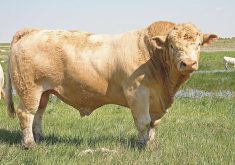With Alberta no longer having an active fruit-breeding program, the University of Saskatchewan is the primary research centre.
Sour cherries, haskap berries, and apples head the list of current breeding efforts at the university’s fruit program, which has been selecting cold-hardy plants for superior fruit quality and yield for over 80 years.
“We actually have three collections that are the best in the world,” said Bob Bors, an assistant professor and project lead of the program.
“In saskatoons, it’s not surprising that we would have the best. We also have the best world collection of haskap.”
Read Also

VIDEO: Claas Axion 9 tractors showcase comfort features
German equipment manufacturer Claas showcased its new Axion 9 tractor series, including farmer-focused cab features, at the Agritechnica 2025 machinery show in November.
The U of S fruit program ( www.fruit.usask.ca) also has an excellent collection of strawberries, as well as indigenous species left over from a native fruit-breeding program. It also maintains a gene bank of many species, since some of them can die if sent farther south.
The emphasis is on developing plants with commercial potential. In berries, they want fruit robust enough to be mechanically harvested, said Bors.
Breeders often cross wild varieties with cultivated ones known for producing good-tasting fruit, hoping to produce new lines with the attributes of both. The university has more than 30 acres of fruit on its campus and grows seedlings at more than three times the normal density in order to test more varieties at a time.
“When we see something that tastes good, then we kill the ones around it and let it flourish or we propagate it to a new place,” said Bors.
The department cooperates closely with growers, hosts workshops, and involves growers in testing new varieties.
The focus on foods with special health properties is spurring interest in northern fruits, Bors noted.
“Cold-hardy species tend to be short little guys,” he said. “They also tend to have a lot more antioxidants with health value because they’re fighting tougher elements than anywhere else in the world. Our bushes tend to be dwarf and tend to have high health value.”
Researchers in the program are also working with strawberries, apples, and grapes.















